|
The
Indian building material sector is one of the main reasons for the
high cost of housing in India, keeping it out of the reach of the
poorer households in rural and urban settings and also the largest
single contributor to environmental degradation and depletion of
natural resources in India. The urgent need to redress the situation
stirred a lot of initiatives, both at national and international
levels. The Swiss funded Buildings Material Project, on-going since
1998, targets the Indian building material sector to help find
sustainable solutions for the shelter crisis by striving to make the
options of Cost Effective and Environment Friendly (CEEF) building
technologies prominent and acceptable, both as shelter solutions and
viable market enterprises. Although all project partners have
individual strategies targeted at their focus areas, Capacity
Building was identified as one of the key components of the
project, with every partner addressing the issue according to its
own strategy. The project seeks to address the training deficiencies
regarding product quality, marketing and business management in the
building materials sector.
The
Human Settlement Management Institute was engaged to carry out a
survey identifying all actors involved in training in the
Construction sector and assess the training demand and supply of
CEEF technologies in the five BMP states, namely- Orissa, Madhya
Pradesh, Kerala, Andhra Pradesh and Tamil Nadu. The categories
of actors identified were policy makers, architects and engineers,
site supervisors, building material producers and applicators
(masons and other workforce). It was understood, for the study, that
demand and supply of training in CEEF technologies is indirectly
dictated by the supply and demand of the technologies themselves in
these states.
Training
Supply - A view across the states
|
The
dissemination and the consolidated presence of CEEF
technologies vary considerably across the states. Some notable
success stories are marked by fairly strong training
components, both formal and informal. The Southern states
present a much wider outreach due to a fairly strong Building
Centre movement. Auroville in Tamil Nadu and Mitraniketan and
Inspiration in Kerala embrace a holistic ‘CEEF approach’,
largely absent from the scenario. Kerala, which demands to be
seen in the post-penetration phase of CEEF technologies has
the highest concentration of individual practitioners and
organizations to implement CEEF technologies. Also, largest
number of architects and engineers get trained in CEEF
technologies in the state mostly through the on-the-job model.
Tamil Nadu has benefited from strong Government support and
also has some NGOs committed to CEEF technologies and training
beneficiaries in their use. Andhra Pradesh, with widespread
activity in the Govt. EWS housing sector through the network
of Nirmithi Kendras, boasts of structured training in largest
numbers. |
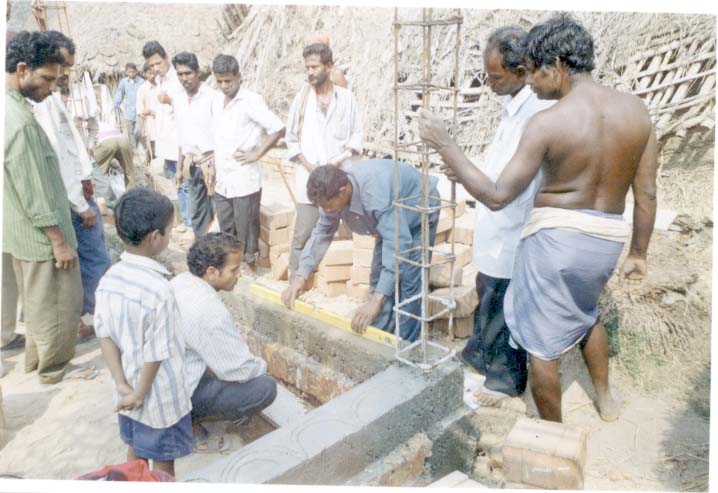
|
|
Training
masons in the DA-CARE "Ashraya" Project, Orissa |
Academic
institutions in MP like Samrat Ashok Technological Institute (SATI)
have been the first to include CEEF technologies in their formal
curricula and also organize training for teachers in these
technologies. Taragram Nirman Kendra has successfully made planned
interventions in the Bundelkhand region to disseminate technology
and ensure sustainability through micro-enterprises. The post
cyclone reconstruction has seen Orissa as a late entrant to the CEEF
sector, but one where phenomenal volumes are addressed, although the
quality is suspect in many cases. Both DA-CARE ‘Ashraya’
programme and the UN House programme, have trained masons,
supervisors and local network partners and ‘Ashraya’ project has
set up Building Material Service Banks that are envisaged as
commercially viable enterprises in the long run. The District
Primary Education Programme(DPEP) in the study states, especially in
MP and Orissa, with its approach to rationalization of designs while
demonstrating CEEF technologies has indirectly given a big boost to
the penetration of CEEF technologies and has developed good models
of "supervisor’ training. Women have demonstrated tremendous
potential as competent masons, most notable instances being the
Jeewapoorna Women Masons Society in Kerala and the widespread ‘Anganwadi’
programmes in Andhra Pradesh.
A
view across categories of actors
HUDCO
has been in the forefront, and indeed, the torchbearer of the effort
for the wide dissemination of CEEF technologies. One of its most
significant initiatives has been the nationwide setting up of
Building Centres which, with their mandate of technology transfer,
have training as one of their primary objectives and form the
single largest suppliers of training in CEEF technologies. However,
in many cases, building centres conduct training in response to
manpower demand for executing projects, barring which, lack of
finance for training is a common complaint. Habitat Polytech,
supported by HUDCO, having reached all parts of the country
specializes in ‘barefoot training ‘ for masons and supervisors
and in conducting training of trainers (TOT).
For construction
workers (applicators), particularly masons, the only formal
training mechanism for conventional building technologies attempted
through the government Industrial Training Institutes (ITIs) has
failed, as those trained have become supervisors. Another initiative
is the Construction Workers' Training Institute (CWTI) targeted at
the construction workforce of larger construction firms and also
actively advertising its services. Organisations like NBCC and L
& T have rigorous in-house training programmes. NICMAR has done
pioneering work in formulating job descriptions and skill standards
for several building trades.
INSTRUCT,
an NGO in Bangalore, has taken up training in masonry as an
exclusive activity and has been active throughout Karnataka. The
Contractor’s Development Institute (CDI) at Hyderabad is a
laudable new initiative with the focus on the 90,000 odd Class A contractors,
who are bigger players in the market. Capacity Building for building
supervisors in CEEF technologies has been largely carried out by
HUDCO for the Project managers of Building Centres, in two -week
workshops, run alternately at HSMI and at Chennai.
Building
material producers,
a small but very significant category, are mostly self-made
entrepreneurs surviving by trial and error. Most common and informal
support is technical instructions on purchase or installation of
machinery. Some exceptions exist in the case of bigger machine
manufacturers, who ensure proper training and follow-up. Architects
and engineers need to be an integral part of any training
strategy for CEEF training and dissemination, preferably by suitable
modifications in the academic curricula which at present mostly do
not address the issue at all. There are instances of training
engineers at building centres as part of specific projects but it is
not regularised. Policy makers represent a key group who are
presently hardly covered by any training/orientation. Their support
is crucial both for improving the supply and generating demand for
CEEF technologies and training. Some Building Centres, such as
Nirmithi Kendra ,Dhar are training Panchayat officials, who are key
policy implementors in the wake of the seventy-third Constitutional
Amendment.
Content
and methodology of training
|
Attitude
of the trainee is the most important factor for the success of
the training. Commitment and conversion to the cause of CEEF
technologies is more critical than knowledge and skills.
Well-structured training programmes are rare and so is the
understanding of their benefits. Almost all structured
training in CEEF technologies and even in the conventional
construction sector can be said to have the following
characteristics: |
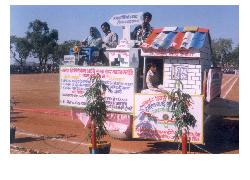
|
|
A
mobile exhibition of CEEF technologies
by Narmada Nirmithi Kendra, MP |
| t |
The rationale of ‘Why CEEF technologies?’ from ideological and
environmental point of view is hardly covered.
|
| t |
Contents of training pay little attention to quality control in
construction. This becomes even more important since a large part
of training is on the job.
|
| t |
There is a lack of properly designed training aids and manuals. A
direct relationship between good training aids and the resulting
high efficacy of training aids emerges clearly
|
| t |
Training is often conducted by technical persons with occupational
skills but no instructional skills
|
| t |
Method of evaluation of training is absent/
non-structured/informal in most cases.
|
| t |
Feedback from training is ad-hoc and often considered unimportant.
Mostly, no attempt is made to keep a record of the trainees.
|
| t |
Certification, if any, is usually based on participation and not
on performance. A mechanism which makes a training certificate a
valuable document , particularly for the mason trainee is
certainly desirable. |
Training
Demand - a view across the states
| On
the face of it, the greatest demand for CEEF technologies exists in
Kerala and in isolated pockets of other states. Even in Kerala, the
movement needs to be revived by infusing the same with greater
qualitative and aesthetic value. In Tamil Nadu, it is reasonable to
assume hidden demand , since the state has a considerable populace
to whom CEEF approaches combined with aesthetics and economics would
have considerable appeal. In Andhra Pradesh, categories other than
EWS must to be tapped. The excellent demonstration projects and the
existing data base on resources and technology possibilities can be
used to advantage to capture public imagination. In Madhya Pradesh,
an efficient networking amongst existing institutions is all that is
probably needed to make CEEF technologies cross the critical mass
and in turn generate demand. In Orissa, the huge demand for skilled
masons in the post cyclone reconstruction activity has to be
channelised towards CEEF technology options. Also, high visibility
buildings and awareness generation at all levels is an area of
special attention in Orissa as compared to the other states. |
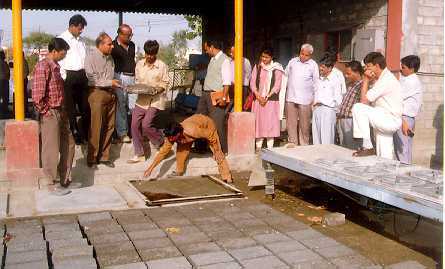 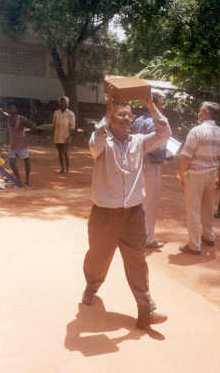
Hands-in-pocket
training
Hands-on training |
|
Addressing
key target groups
There
is no continuity in the demand and supply which breaks with each
project cycle. There is loss of trained manpower because of no
continuity of work. Various types and levels of skill are required
in the construction industry, which has no control at the moment on
skill levels. One positive policy level demand generation initiative
in this regard is the inclusion of a clause in construction
contracts, specifying the percentage of trained manpower to be used
in the project.
Many
practitioners in the building sector, namely architects and
engineers, are not conversant with CEEF technologies, especially the
hardened government engineers who are difficult converts. Master
masons and small contractors are responsible for a majority of
construction activity in the country, and can be addressed and
oriented to act as agents of change and in turn trigger demand
generation. The recent earthquake in Gujarat has focused the country’s
attention on the quality of construction practices. This must be
used to advantage to project earthquake -resistant CEEF technologies
as the appropriate solution for the beneficiaries of the numerous
rehabilitation and reconstruction programmes.
|
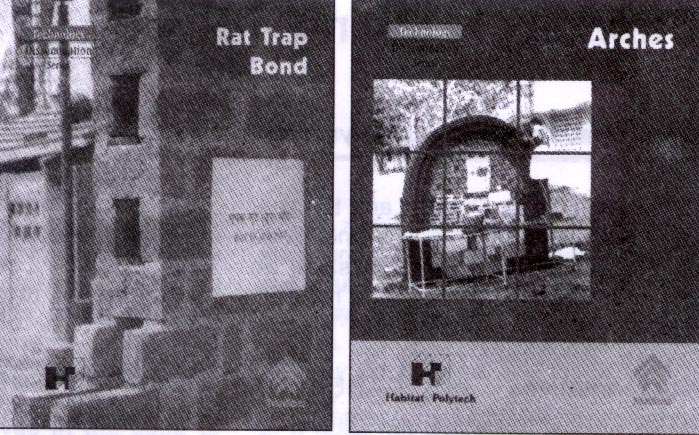
|
| |
A
part of the 12 technology booklet series developed by HUDCO's
Habitat Polytech, New Delhi |
Key
Recommendations
| t
|
A
conscious effort must be made to counter a very common
misunderstanding of CEEF technologies merely as a set of walling and
roofing options and present it as a holistic
approach.
|
| t
|
Of
all the trades, the Construction Worker i.e the bricklayer or mason
deserves priority attention. Here, equal attention must be paid to
training in good masonry practices, as much as to skill
building in CEEF technologies.
|
| t
|
Database
of
all CEEF related agencies/ agents/documentation on projects/ and
networking amongst CEEF practitioners is a prime focus area.
|
| t
|
The
conduct of training has to be made financially attractive for
Building Centres. Building Centres must consciously change their
focus from production of cement based components to acting as
resource centres. Management skills of Building Centres'
project managers have to be strengthened.
|
| t
|
Training and support related to
enterprise development
through CEEF technologies must be paid serious attention.
|
| t
|
All
training to clearly include ‘Why is CEEF relevant? i.e.
attitudinal skills must be inculcated. Quality of
construction/products must form an important part of any training
intervention. Training evaluation must be done and skills imparted,
should be reviewed after field application. A standard system of
performance certification has to be introduced.
|
| t
|
The momentum and interest generated in the post-earthquake scenario
should be used to introduce CEEF earthquake resistant building
options to the general public through execution of
high-visibility and good quality demonstration projects.
|
| t
|
The user has to be flooded with information from all possible
media. Awareness generation at all levels, including
professionals, is of crucial importance. The training
strategy should attempt to reach NGOs, particularly those
that are working in allied areas such as energy .Networking
between practitioners and manpower sharing could be a
strategy evolved to retain trained manpower. |
q
Gayatri
Ratnam is a Fellow at Human Settlement Management Institute,
New Delhi
and
Pankaj Khanna is a Building Technologist at Development
Alternatives.
|
CLEANing
SOUTH ASIA |
|
Community
Led
Environment
Action
Network
(CLEAN) Programme
is slowly but firmly taking roots, not only in our country but
also in neighbouring South Asian countries. World Vision
(Nepal), at present working in Kathmandu on aspects of building
infrastructure, health and sanitation, education and other
social issues has decided to start a CLEAN-Nepal Programme.
Starting with pilot phase activities in the Kathmandu Valley in
the first year, they plan for a country-wide expansion and have
identified Development Alternatives as programme consultants.
A
team consisting of Col V. Katju, Dr. K. Vijayalakshmi and Ms.
Anuradha recently visited Kathmandu for extensive discussions
with World Vision. The visit afforded the opportunity of first
hand interaction with the community and also a glimpse into the
existing environmental issues to be addressed, issues endemic to
most developing countries. River Baghmati, a once-swift flowing
river that is now a veritable drain, is the regular recipient of
blood and non-consumable remains from the carcasses of buffaloes
disposed off by butchers residing in a nearby slum colony. The
water supply to Kathmandu township provided by borewells and
springs does not meet the demand and is also poised for a high
incidence of water-borne diseases. The absence of a regularised
solid waste management system of the Metropolitan Council of
Kathmandu results in random open garbage dumps in residential
areas. However, a positive attitude was evident during a visit
to Bungmati village, where wicker baskets in wrought iron stands
for collection of household wastes provide a semblance of order.
The
districts of Kathmandu, Lalitpur and Bhaktapur have been
assigned to three Area Development Programme (ADPs) locations
and the ADPs will get in touch with local NGOs with a proven
track record of dedicated work towards environment. Also, World
Vision (Nepal) will get in touch with Village Development
Committees (VDCs) and initiate action to suit their local
environmental condition with help from schools.
The DA team visit to a VDC and two schools at Bungmati in
Lalitpur District found a favourable response among enthusiastic
principals, teachers, school children and citizens who were
willing to devote extra hours for the community. The Cooperative
School is run by contributions from the community and it is well
organised. To prevent people from using river banks as garbage
dumps and also to attenuate soil erosion, it was suggested to
initiate extensive plantation of trees, with the communities
sharing responsibility for looking after them. The DA Team also
met the Traffic Police Chief of Kathmandu and suggested regular
pollution control checks and avenue plantation in existing wide
areas as measures to counter air pollution from vehicular
traffic. Also, sign boards could be placed at traffic junctions
giving data of ambient air to include SPM, NOx and SO2 for
creating a general awareness among the people.
One message, which is clearly perceived, is that the school
children strongly believe that adults have failed miserably in
the environment upkeep. They have the drive to co-ordinate
various activities on environment mitigation and are being
backed by the SAARC governments in their endeavour.
Col.
V. Katju (Retd.)
Manager, Environment Systems Branch |
|



